| Home • Central and South America • Chile • '04 Oct: Patagonia | Click HERE and all the pictures will get big. |
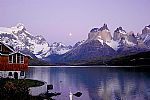
|
It's true! |
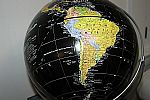
|
My first stop - Punta Arenas - there at the very southern tip of Chile, a spit from Antarctica. I will execute this map idea again as soon as I finsh the pictures of the rest of the trip which I Hope will be sometime before the new year. |
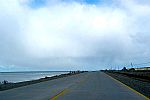
|
Arriving in town after something like 20 hours of travel my new best friends Wilson the driver and Ramon the guide pick me up at the airport. I have an hour or so at the hotel, brush my teeth, and we’re off for a drive to see some sights. Oh I am happy. Sightseeing! Let’s go!! Notice here it is Flat… more topography to come. |
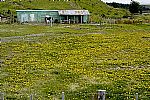
|
We, being me and Wilson and Ramon have been together for about five seconds and I’m already in a twist. OOoowAH can we stop huh-please-just-for-second-huh-pleeease? Foto-foto! became our mantra and rib-poking joke. From time to time Wilson would stop the car on his own and turn to me and say ‘foto-foto?’ or Ramon would point out a sight and in an insistent voice would say ‘foto-foto!’. |
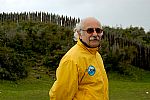
|
Ramon. For one hour it was cold and blustery and I did wear my hat and scarf. That was it for cold. The stroll to the penguin colony was cool, so I could use the hat again but not the scarf. And not the two wool sweaters or the extra pair of leggings or the gloves. And when I think of the weight I could have saved in my suitcase! But then for that one hour I was mighty glad to have it. |

|
This is a made-for-the-tourists restored fort. Ramon said they'd rebuilt it a few times already. Here we see an example of the adobe construction that grew up around the Europeans, not a native technique but cheap and useful. The Spanish first came here in 1584 but they all starved to death. Then in 1843 the Chileans sent a schooner manned by the islander Chilotes and an English officer to occupy the area and they were pretty much driven out by the elements too. And as was so often the case everywhere, the few indigenous people all died of European diseases. |
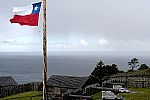
|
The flag of Chile. In the grand tradition of God Bless America, from a local tour operator's website: 'The blue represents the sky of Chile, blue and free. The red stripe stands for the blood shed for Chile's independence. The white stripe shows the snow on the massive and beautiful Andes Mountains. The white star in the blue corner allows us to see their progress and honor.' |
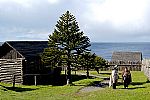
|
This is the national tree of Chile called locally the Monkey-Puzzle Tree, sometimes called the Chile Pine in the US and to be precise, Araucaria auracana. It looks like long rows of thick prickly succulent leaves attached to the limbs of the classic form of 'tree'. |
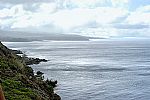
|
A view from the fort. The next picture shows fishing boats that are positioned at one of the inlets along this coast. |
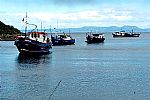
|
This view? |
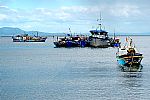
|
or this one or both? |
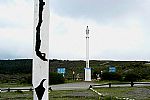
|
Another tourista stop. Even Ramon couldn’t tell about the place with much of a straight face. The star marks the spot where you stand and where you stand marks the exact middle distance between the northern most end of Chile and the southern most end of Antarctica. So there. I don't remember about the Mary... |
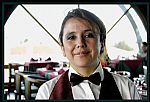
|
We’re back at the hotel in Punta Arenas where I was presented with my first Pisco Sour, the national drink of Chile and drunk at absolutely every opportunity. Pisco is a liquor made like Italian grappa, which they then blend or shake with fresh lemon juice, powdered sugar and ice. Some places add an egg white but it isn’t strictly necessary. Yumm. Since it doesn’t get dark until 10pm-ish I walked around the town a bit and ate dinner at the hotel. I asked for both menus, English and Spanish to study up a little on the vocabulary of eating and discovered that the dishes and the prices were different on the two menus(!). So all the staff gathered ‘round in a flurry of confusion and to my great amusement they attempted to explain, as in ‘oh, that item is out of season’ or ‘oh, you get more if you order this instead of that’. King crab is a specialty, pretty good here, and I ate congrio for the first time. Congrio is a local fish and so dee-Licious I will look for it back home. Also I developed a real taste for boiled potatoes as apparently no meal is complete without them. |

|
A view of the town from a vista point including the Strait of Magellan. Check out those colored roofs. It is something they do on purpose and looks really cool even from the street. You'll see more of them! |

|
Girls hangin’ out. Just like anywhere. |
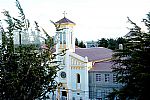
|
Here and following are three pictures of steeples and there were plenty more in this town of about 120,000. Chile is very Roman Catholic with a hint of Lutherans added in for diversity. |

|
Another one. |
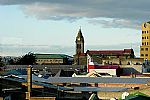
|
More. |

|
This statue is in the center of the main square and commemorates (what?...) but the deal is you have to touch this guy’s toe. You can see that by the glistening. Then one of two things will happen. The stories don't actually conflict - maybe both will happen. You will come back to Patagonia and/or you will have sweet dreams. Both outcomes are welcome so of course I touched his toe. I did have sweet dreams and maybe I'll come back to Patagonia. I also saw pictures of people kissing his toe but nothing in the literature indicated that would be more effective. |

|
Dawn from the hotel breakfast room. We're off at 6:30am heading north to catch the penguins before the tour buses show up and then make our way to Torres del Paine. |

|
The Magellan penguin colony is on the eastern bank of the Seno Otway inlet. There are inumerable islands and inlets down here so it's pretty much water water everywhere. The walk around this protected reserve was quite excellent, well maintained paths, clean facilities etc. Various sources allow that 10,000 breeding pairs of penguins nest here from October to March and here it is November but... |

|
I have heard back from Ramon and will now fill in all the names of the birds. This is the gorrion, also called the house sparrow. |

|
Here we have the caiquenes, the upland goose. |

|
Penguins and sea gulls. Not really the shoulder to shoulder penguin colonies of Antarctica but still, Penguins! |
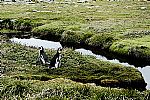
|
The Magellan penguins are smaller and as you can see differently colored than the Antarctic penguins. Maybe because there were so few of them around it felt like you could know them up-close-and-personal. The penguins nest in burrows scattered around areas that look like this. |
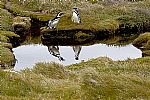
|
Awww. |

|
His head is deep in the grass diving for seeds or bugs, and his beak is needle thin and as long as his body. |

|
Grasslands. Physically this outing was a long flat easy stroll and a nice way to kick off a trip that would end up having been a Lot of walking and not all of it so flat and easy! |
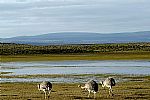
|
These are rheas and there were flocks of them, assuming rheas move in flocks despite the fact that they cannot fly. They totally cracked me up. They move so entertainingly with their truly bizarre shape and ambling gate and undulating neck. |
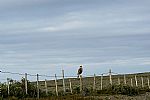
|
This guy is the crested caracara. |
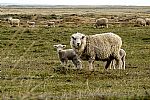
|
My idea about the people of Chile is that if you could imagine a country called EU you’d get a feeling for who lives there. From what I could see and from what people told me, the country is populated 95% by a vast mix of European immigrants. (PS, when pressed Chileans admit that discrimination against non-Europeans is pretty universal.) You’ve got your Spanish of course, and Portuguese and Germans by the boat load. Also Basques, and French, Irish and English and a ton of Croatians and no doubt many more I left out. Because the country is so long and so flat and so mountainous and so wet and so dry with all variety of stick and stone and a vast coast line there is a place for every talent, which is what drew all these hard working immigrants in the first place. I put this rap here so I could mention the sheep. How adorable is that baby?! In the late 1800s the territorial governor brought over 300 sheep from the Falklands. Sheep flourished here, and the vast estancias (‘great cattle- or sheep-grazing establishments with a dominant owner and a dependent resident labor force’) developed which wouldn’t have happened without the many sheeep-farm-experienced immigrants. |
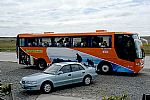
|
That’s our car with a big tourist bus pulled up behind. The whole tour bus scene was quite impressive – all of them like this one – new, clean, imaginatively painted. I especially liked this one because you’ll notice the figures along the back side. This is Dad in his rancher get-up and his three gaucho daughters who run the business. Wilson and Ramon knew every single person on our route. We have stopped here for coffee and a chat and for me to see a must-see for all the tourists who pass by. You'll soon see why. |

|
The Guy. |
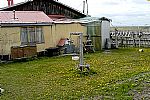
|
The back of the little coffee and souvenir shop where The Guy and his wife live. And where Pancho lives. |
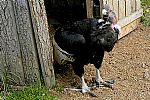
|
Meet Pancho. Pancho is a full grown Andean condor. His head reaches above my waist and check out those feet. The story is that Pancho’s mom, like all good condor moms, at some appropriate condor-mom moment, pushed her baby out of the nest. This is when condors realize flight but Pancho did not take wing and rather made a messy thud-crash landing. Mom immediately abandoned Pancho as one Loser condor. Ol’ Pancho has in fact never flown but his wing span is something like 12 feet. There's more to say about condors in the Peru section but this is my only picture and although it is odd to see him here in this Thanksgiving turkey pose instead of as a spot in the sky, at least you Can see him and marvel at those awesome claws. |
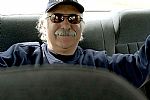
|
Right at the airport, as Ramon went to sit in the front seat I right away, not being shy, asked if I could sit in the front seat, being as I was the customer and all. They thought it a bit odd (little did they know...) but agreed because I was indisputably the customer. So that was our seating arrangement from then on and Ramon had to lean forward to be the guide but I got the best view. Can you just imagine the luxury? I had the full attention of two great guys whose only task was to see to my amusement. I held the camera backwards over my head and took this shot. |

|
My normal view of Wilson. |
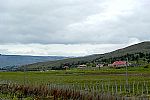
|
Here is an example of a small estancia. |
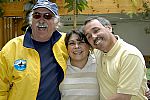
|
Like I said, Ramon and Wison knew everyone everywhere we went, hugs and kisses all around. |

|
We ate lunch here. Except for the first night when I was on my own and ordered the King crab and congrio, the food on this part of the trip reminded me of Hawaiian plate-lunch. I was simply delivered what seemed like a tour-package plate of food: a meat or fish, some cooked vegtables and some boiled potatos. Then dessert came. Breakfast was a modest buffet. This was the pattern for three days and two nights. It was all well prepared and fresh, fine really, I just have no real idea about the variety of food in Patagonian - unless maybe I do... |
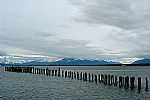
|
A view from the road heading into the small town of Puerto Natales, base camp for ferries that move cargo and backpackers through the fjords, and a kickoff point for the thousands who visit Torres del Paine. My guys told me to pronounce Paine like a pine tree plus eh as in TORR-ehs del PINE-eh. An article I read recommends TOR-ehs del PIE-nay. Take your pick. It is a natural wonder on a scale of Yellowstone and Yosemite and of course my two nights are such a tiny representation of all that is there. Notice the glow in the sky in the middle far right. This told the guys we should high-tail it to the park because it looked like the clouds were lifting. |
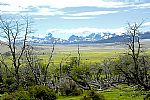
|
First full views of the mountains to come and Torres del Paine National Park. LP: 'Before its creation in 1959, the park was part of a large sheep estancia, and it's still recovering from nearly a century of overexploitation of its pastures, forests and wildlife. In 1978 it was declared a Unesco Biosphere Reserve.' |
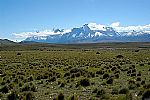
|
More. The range is called Paine Massif, 'medium high mountains emerging suddenly from the plains of the Patagonian steppes'. |
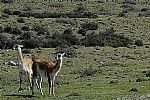
|
Here we have guanaco, in the same family with llamas, alpacas and camels. When I saw my first pair of these guys I went balistic. Foto!foto!!foto!! Wilson and Ramon were chuckling but I didn't care. Then a few miles later there were a hundred of them and then hundreds more. They move in herds like buffalo in a cowboy movie. |

|
Bad tourist! I have pictures of two different waterfalls. I can clearly remember the difference, how it was getting there, what we talked about etc. etc. etc. but I can't remember the names! |

|
A closeup from further up the river in the picture above. |
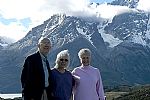
|
I visited with these folks on the plane and then we ran into each other in town and had a nice chat and then, when we ran into each other here too we just had to have a foto. |
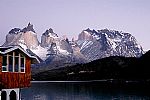
|
The view from my window at our hotel, Hosteria Pehoe, on the shores of Lake Pehoe. |

|
As for my two days there, all the locals in the park and in town and those who saw these pictures – all of them – said that in any entire year there are not even five days as clear and bright and warm and free of wind as my time in the park and adding all the irresistibly adorable baby animals we saw, amazingAmazingAMAZING was the universal exclamation. The moon at sunrise. |

|
A view from the bridge that leads to our hotel. Irresistible foto-foto. |
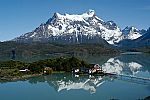
|
This is the whole site - bridge, hotel, lake and killer mountain. |

|
Here's a pano from a different perspective and you can see the main landmarks that are visible from most of the park. The bit on the left that looks like a saddle is called Paine Grande and on the right is Los Cuernos, The Horns. |
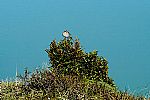
|
This little cutie is the churrete austral, or the tussockbird. |

|
|
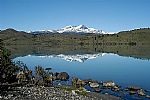
|
Be grateful for all the ones I Didn't include! |
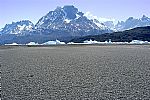
|
This is the beginning of the walk to view the face of Grey Glacier. We trudged along for about a mile on this pebble and sand beach and then climbed for a good while to see some vistas. |
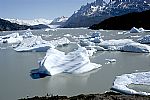
|
Oh yeah. |
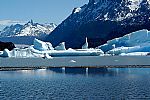
|
Wow. Torres del Paine is most well known for its appeal to backpackers and the glory of the trekking. There are two main routes - the 'W' which moves you around the major peaks and 'the Circuit' that is the W plus 'the backside'. The Circuit takes seven to nine days, all camping out, the most challenging part being the weather. They say you get all four seasons in a day, all complemented by ground level clouds and gale force winds. I of course wouldn't know as my two days were perfection itself. |

|
Touristas. |

|
...or else this one is the churrete austral - Ramon, we've missed one! |
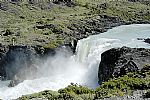
|
The other waterfall. |

|
Neato. |
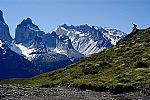
|
Wilson. I asked him how he got that name. He said his mother liked all kinds of names... (get all the sibling's names). |
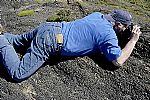
|
Ramon is setting up his camera for a group shot, so we could all be in the same picture but I didn't know that at the time. He is hanging off the edge of a cliff here and is leaving his camera teetering half on the ledge and half off. I'm holding my breath and saying what? what?. |

|
The edge... |
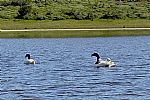
|
Like the weather, this sight caused gasps of enthusiasm from Wilson and Ramon. You can see this scene in a postcard but even though Ramon had traveled in this park since its inception, he had never seen for himself the babies on the mother's back. Every bus and car that passed screeched to a halt and tourists poured out to take this picture and even the guides were all a-buzz. I had to run off down to the lake bank, with windmill arms against the flurry of attacking mosquitoes because the swans kept moving further and further away, much to the merriment of W&R, but at least by now they were getting used to it. |

|
more. |

|
Hello Mr Fox. |
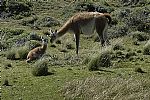
|
The baby guanaco are called hulengo and this one, according to Ramon, is not more than three days old. Just minutes before he had been gamboling around the pasture and then plop, he decides to take a break and mom comes 'round to check. Kisses... |

|
A rhea and His babies. That's right, Dad is in charge! |
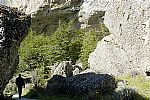
|
Cueva del Milodon. |
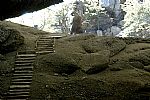
|
In the 1890s Hermann Eberhard discovered the remains of a huge prehistoric ground sloth, the milodon, that became extinct in the late Pleistocene. A very modest walk takes you into its cave and this is a shot looking out at a full scale model of the milodon. That's it. Tourist attraction. |

|
That night's sunset from inside the hotel. |
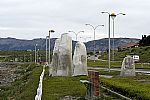
|
We're up the next day to start back to Punta Arenas where I will join the ship that afternoon. Your eyes do not deceive you. That Is a hand. Hi. Bye. |
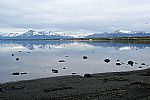
|
I'm waiting by the side of the road in the picture above while the guys get gas. So what to do? Why foto-foto of course. |
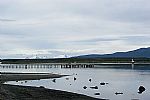
|
I've got a shot of this going into the park. I know that and yet... |
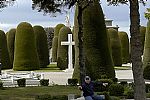
|
The Cementerio Municipal. Rich in life and death. |

|
More. |

|
Representing the pioneers. So it was in the program that we were to do a city tour - see the museums, the public buildings, the scenic drive. Ramon was slumping his shoulders so I would be sure and see. He was heaving sighs. What? 'City tours are such a drag but ok let's go.' Fine. Fine. Fine. No problem. What are you going to have in these museums anyway? Let's do something else. |
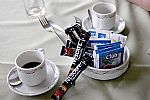
|
So we had a Pisco Sour and lunch and coffee. ALL coffee in Every restaurant was this coffee. |
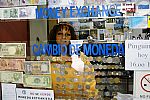
|
We went to meet Ramon's sweet wife Paulina, get some maps, find jam made with the berries that only grow here... |
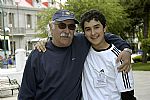
|
...and find Ramon's son Rodrigo. Rodrigo is 14 and got to take the day off school to 'work the buses' for Crystal's city transfers. He saw us from across the street and called 'ola viejo' 'hey old man', beaming and rushing over, throwing his arms around his dad and at the same time pulling his tips, a wad of dollar bills, from his pocket. It was utterly charming. Another cute thing - Ramon would call home every night and his wife would ask him 'so, how is your tourist?'. For some reason that really tickled me. |
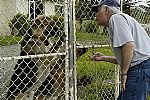
|
Then we went to Ramon's house to look for the sea lions that they had spotted in the bay. Big dogs! |

|
The road in front of the house. |

|
Yup, the sea lions were there. |
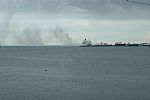
|
Crystal Symphony. And all that pollution is from shore - an uncontrolled fire of burning wood chips I heard. (Note: if 1/1000 of this smoke was coming out of the ship's stack we would be Toast with the authorities.) So now goodby to Wilson and Ramon, with hugs and kisses and grateful thanks and fondest memories. You can go directly to: Patagonia, the Chilean Fjords, Cusco and Machu Picchu, and the Amazon Rain Forest. |
| Home • Central and South America • Chile • '04 Oct: Patagonia |
© 2014 • WhereTheHeckIsMom.com